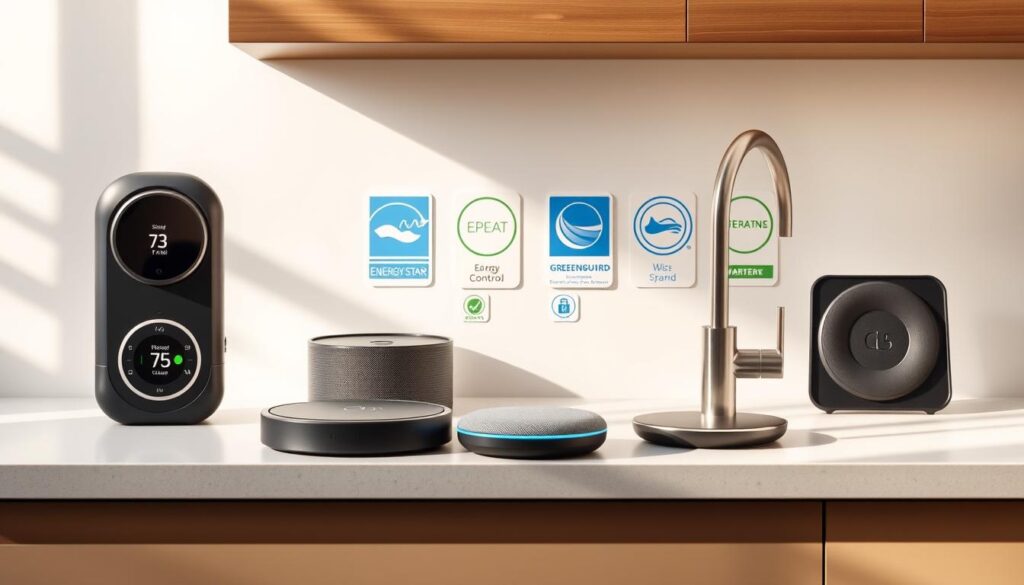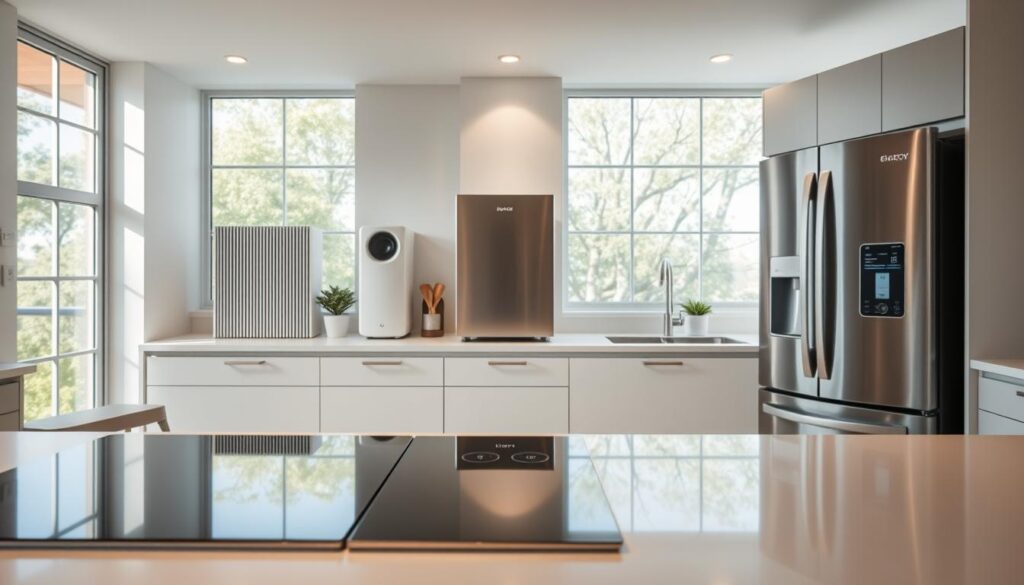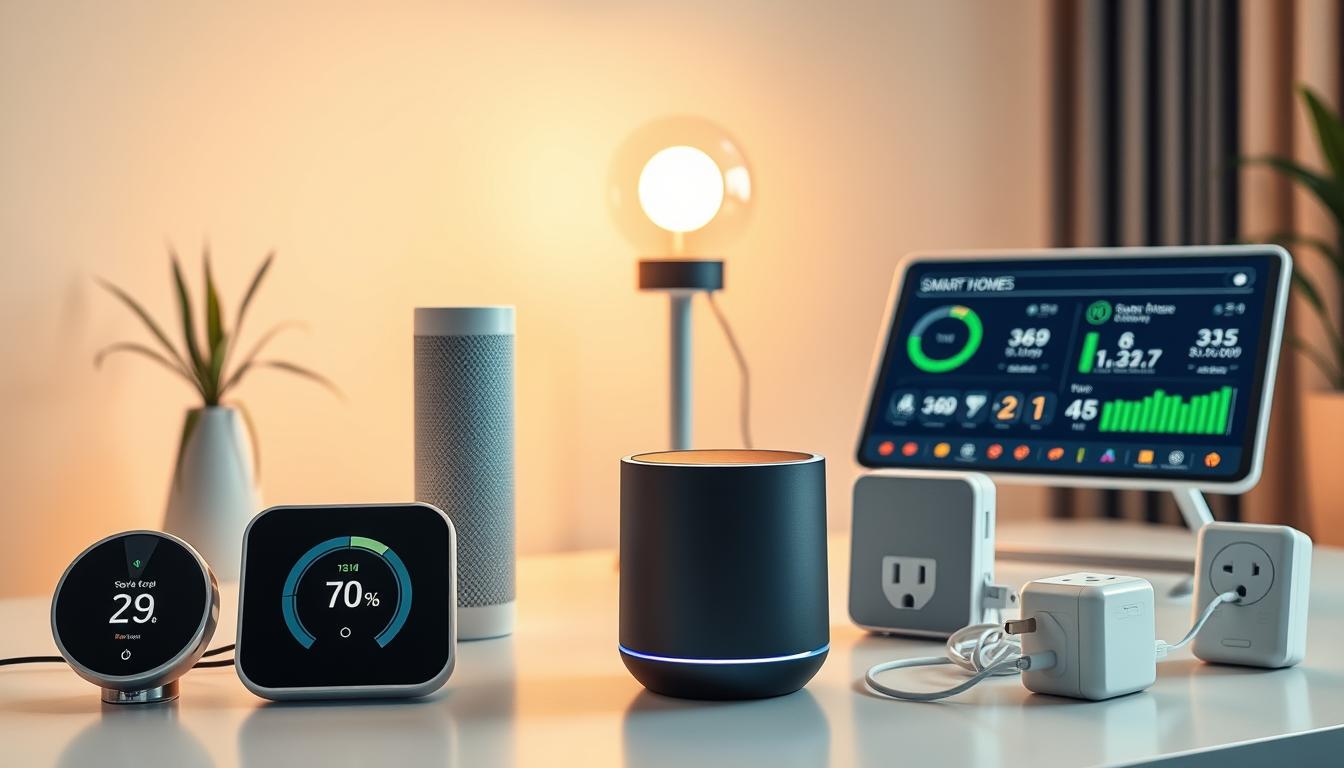Imagine a home where everyday gadgets help protect the planet. Eco-friendly gadgets for home are changing how we live. These innovations cut energy use, reduce waste, and make sustainability simple. From solar-powered chargers to smart water savers, these tools turn small choices into big environmental wins.
Key Takeaways
- Eco-friendly gadgets for home boost energy efficiency and lower carbon footprints.
- Smart devices like LED lights and smart thermostats save resources without sacrificing comfort.
- Investing in sustainable tech helps families support environmental goals daily.
- These innovations offer long-term cost savings and improve home functionality.
- Choosing certified products ensures gadgets meet strict eco-friendly standards.
Introduction to the Green Tech Revolution
From smart thermostats to solar-powered chargers, sustainable home products are reshaping daily life. This shift isn’t just a trend—it’s a response to urgent global challenges like climate change and resource scarcity. Let’s explore why this transformation matters and how it’s changing households across the U.S.
Understanding the Shift to Green Technology
Three factors drive this movement: consumer demand, policy changes, and innovation. Companies now prioritize eco-friendly designs to meet buyer expectations. Governments are incentivizing energy-efficient appliances through tax breaks. Meanwhile, tech advancements make sustainable home products affordable and accessible.
- Climate goals push industries toward greener solutions
- Consumers seek products with verified environmental benefits
- Cost savings from energy-efficient devices attract households
The Importance of Eco-Friendly Home Innovations
“Investing in sustainable home products isn’t just ethical—it’s practical. These items save money while protecting natural resources.”
Take smart irrigation systems that reduce water waste or LED lighting that cuts electricity use by 75%. Such innovations lower utility bills and shrink carbon footprints. Brands like Philips and Nest lead the way, offering tech that blends performance with responsibility. By choosing these products, homeowners join a broader effort to create healthier, planet-friendly living spaces. This shift isn’t optional—it’s a necessity for future generations.
The Journey Towards Sustainable Living
The push toward eco-friendly living isn’t new. It’s a story of innovation and adaptation. Decades ago, green home technology began with simple steps like recycling programs and energy-efficient bulbs. Over time, these efforts grew into advanced systems shaping modern homes.
| Year | Key Milestone |
|---|---|
| 1970s | First solar panels installed in residential areas |
| 2000s | Smart thermostats (e.g., Nest) reduce energy waste |
| 2020s | AI-driven home energy management systems |
“Sustainable living isn’t a trend—it’s a necessity. Every home innovation brings us closer to balancing comfort and conservation.” – Dr. Elena Martinez, Sustainable Tech Institute
Today’s green home technology blends convenience with planet care. Solar roofs from Tesla, water-saving showerheads, and smart grids show how far we’ve come. These tools aren’t just gadgets—they’re steps toward a greener future. As we look ahead, each choice in home tech becomes part of a larger story. Every small change adds up, proving sustainable living is within reach for everyone.
Innovative Features of Green Home Technology
Modern environmentally friendly home devices are redefining how we live. These tools blend cutting-edge tech with sustainability, making eco-conscious choices effortless. From smart systems that learn your habits to materials that reduce waste, innovation drives every aspect.
Smart Energy Solutions
Automation is key. Devices like Nest Learning Thermostats adjust heating based on occupancy, slashing energy use. Pair them with LIFX Smart Bulbs that dim automatically when natural light is enough. These systems work together, saving both resources and money.
- AI-driven climate control
- Real-time energy usage tracking
- Solar-compatible charging ports
Advanced Eco-Friendly Designs
Materials matter. Brands like EcoSmart Living use recycled plastics and bamboo fibers in device casings. Sleek solar-powered Wi-Fi extenders from SunPower blend tech with nature. Design now prioritizes longevity—upgradable components mean less e-waste over time.
These innovations prove style and sustainability aren’t mutually exclusive. Whether it’s a compost bin with odor-blocking tech or a showerhead that conserves water without sacrificing pressure, every detail counts.
Eco-friendly gadgets for home: Your Ultimate Buyer’s Guide
Shopping for eco-conscious home gadgets can feel overwhelming, but this guide simplifies the process. Here’s how to spot the best choices that align with your values and needs.

Key Considerations for Eco-conscious Shoppers
- Energy Efficiency: Look for gadgets with ENERGY STAR® ratings to ensure low power consumption.
- Material Transparency: Prioritize brands that disclose use of recycled or biodegradable components.
- Lifespan: Choose durable products designed for longevity, reducing frequent replacements.
Understanding Product Certifications
Third-party certifications confirm a gadget’s environmental claims. Here’s what to look for:
| Certification | What It Means |
|---|---|
| ENERGY STAR® | Meets U.S. EPA standards for energy efficiency. |
| USDA BioBased | Contains verified plant-based materials. |
| Forest Stewardship Council (FSC) | Guarantees wood products come from responsibly managed forests. |
Always check labels and manufacturer websites for certification details. Remember, eco-conscious home gadgets that lack these badges might not deliver on their green promises.
Energy Efficiency and Eco-friendly Home Appliances
Energy-efficient appliances are key to green living gadgets that cut energy use while keeping homes comfortable. Modern refrigerators, washing machines, and air conditioners now come with smart tech that adapts to needs, slashing power waste. These devices not only help the planet but also save money over time.
- Refrigerators with adaptive cooling use 40% less energy than older models.
- Washers with eco-modes reduce water and electricity by up to 30%.
- LED lighting systems last longer and use 75% less energy than incandescent bulbs.
| Appliance | Key Feature | Popular Brands |
|---|---|---|
| Smart Thermostats | Learn usage patterns to optimize heating/cooling | Nest, Ecobee |
| Energy Star-certified Dryers | Condensation tech eliminates venting needs | LG, Samsung |
| Solar-Powered Chargers | Convert sunlight into usable energy | Goal Zero, RENOGY |
Many green living gadgets now integrate IoT connectivity, letting users track energy use via apps. For instance, Philips Hue bulbs adjust brightness based on natural light, while Whirlpool’s smart ovens preheat only when needed. Upgrading to these appliances starts with checking Energy Star ratings and comparing kWh savings. Small changes like these add up to big environmental wins without sacrificing convenience.
Integrating Sustainable Living Gadgets into Daily Life

Transforming your home into an eco-friendly space starts with simple, everyday choices. eco-friendly home appliances like smart thermostats or solar chargers fit seamlessly into routines, saving energy without sacrificing convenience.
Everyday Applications for Green Tech Devices
Begin with small changes. Use a smart thermostat to adjust heating automatically when you’re away. Solar-powered phone chargers work anywhere—perfect for picnics or travel. Even kitchen gadgets like energy-efficient refrigerators cut costs and emissions. Here’s how to start:
- Replace old bulbs with Philips Hue LED lights
- Pair a Nest Learning Thermostat with an energy monitor
- Choose Wi-Fi enabled plugs to turn off idle devices remotely
Building a Sustainable Home Ecosystem
“A connected home isn’t just about gadgets—it’s about harmony.” – Sarah Green, EcoTech Advisor
Link devices to create a unified system. For example, a smart irrigation system paired with soil sensors conserves water automatically. Ensure all eco-friendly home appliances work together. Brands like Samsung and LG now offer app-controlled appliances that sync with smart hubs like Amazon Alexa or Google Home.
Start small, expand gradually. Every step—from a solar-powered outdoor light to a water-saving showerhead—adds up to a greener lifestyle. Your home becomes a network of eco-conscious choices, making sustainability effortless and rewarding.
Exploring Environmentally Friendly Home Devices
From solar-powered chargers to smart irrigation systems, sustainable living gadgets now offer practical solutions for eco-conscious households. These innovations blend technology with environmental care, making it easier to reduce energy use and waste.
- Sunforce solar chargers harness sunlight for phones and outdoor gear.
- Nest Learning Thermostats adapt to routines, cutting heating costs by up to 10-12%, per manufacturer data.
- Brondell toilets reduce water usage with pressure-assisted flush systems.
“These devices aren’t just tools—they’re daily reminders to prioritize the planet.” — EcoTech Innovations, 2023
Design trends emphasize longevity over disposability. Brands like ECOVATIVE use mushroom-based materials for packaging and insulation, reducing plastic reliance. Voice-controlled systems like Amazon Echo integrate energy monitors, letting users track real-time consumption via apps.
Many sustainable living gadgets now come with modular parts for easy repairs, extending product lifespans. Apps like OVO Energy provide personalized tips to optimize device efficiency, turning eco-goals into actionable steps.
The Role of Green Living Gadgets in Reducing Waste
Eco-friendly gadgets for home are more than just tools—they’re game-changers for cutting waste. By designing products to last longer and use fewer resources, these innovations tackle environmental harm at its source. Imagine a world where devices like solar-powered phone chargers or smart recycling bins become as common as traditional appliances.
Minimizing Environmental Impact
These gadgets slash waste in two ways: reducing energy use and extending product lifespans. Solar lights, for instance, eliminate the need for disposable batteries. Smart thermostats like Nest learn routines, saving energy without sacrificing comfort. Even small items, such as reusable silicone food wraps, replace single-use plastics entirely.
Long-term Benefits of Sustainable Gadgets
Over time, eco-friendly gadgets for home save money while protecting the planet. A study by the EPA shows that energy-efficient devices can reduce household waste by up to 30% annually. Brands like Philips offer LED bulbs that last 25 times longer than incandescent bulbs, cutting replacement waste. “Sustainability isn’t a trend—it’s a necessity,” says the Green Tech Alliance, emphasizing how these tools turn daily habits into eco victories.
- Reduced landfill contributions through durable designs
- Lower energy bills and resource consumption
- Encourages mindful consumption habits
Choosing these gadgets isn’t just an upgrade—it’s a step toward a cleaner, healthier future for everyone.
Comparing Top Sustainable Home Products
Choosing the right sustainable home products starts with knowing what to look for. This section breaks down leading options to simplify decision-making. See how features and performance stack up in real-world use.
Feature Comparison and Reviews
Leading brands like EcoSmart and Philips Hue stand out in energy efficiency and durability. Key features to compare include:
- Energy star ratings and consumption data
- Material sourcing transparency
- User-friendly interfaces
Performance Metrics to Consider
Look for these measurable benefits when evaluating sustainable home products:
- Annual energy savings percentages (e.g., Nest thermostats save 10-15% on heating bills)
- Carbon footprint reduction claims verified by third parties
- Warranty terms and recycling programs
“The EcoSmart water heater cut my utility bills by 30% in the first month.” – Verified customer review on GreenerLiving.com
Top performers balance cost, functionality, and environmental impact. Prioritize products with clear certifications like Energy Star or Cradle to Cradle to ensure legitimacy.
Future Trends in Eco-conscious Home Gadgets
Imagine a home where every device works smarter to save energy. The future of green home technology promises even bigger leaps in sustainability. Innovations like AI-powered energy monitors and solar panels that adapt to weather are on the horizon. These tools will make eco-friendly living easier and more effective.
- AI-driven automation: Smart systems will learn your habits to cut energy waste automatically.
- Solar tech upgrades: Flexible solar films could soon replace bulky panels, fitting any home design.
- Biodegradable gadgets: Devices made from plant-based materials that decompose safely after use.
- Grid-connected homes: Solar and battery systems will share energy with neighbors, creating community power networks.
Companies like Tesla and Nest are already testing prototypes that recycle energy waste. Experts predict prices will drop as demand grows. By 2030, over 70% of new homes could include green home technology features. This shift isn’t just about gadgets—it’s a smarter way to protect the planet while saving money. The next wave of eco-tech will make sustainability effortless for everyone.
Conclusion
Choosing environmentally friendly home devices isn’t just a trend—it’s a step toward a greener future. From smart thermostats to solar-powered chargers, these innovations cut energy use and reduce waste. Every device you choose today helps build a sustainable tomorrow.
Leading brands like Philips and Nest offer options certified by Energy Star or LEED, ensuring top performance and eco-impact. These gadgets simplify reducing your carbon footprint without sacrificing convenience. Small changes, like swapping old bulbs for LED lights, multiply when communities adopt them widely.
Explore options like reusable water filters or solar panel kits to start. Each choice supports cleaner energy and long-term savings. Join millions already embracing green tech to lower bills and protect resources. The shift to eco-conscious living starts at home, one smart purchase at a time.
Visit the EPA’s Energy Star directory or local retailers to find certified environmentally friendly home devices. Together, these steps create lasting change. Let’s turn intention into action—one device, one home, one community at a time.
FAQ
What are eco-friendly gadgets for home?
Eco-friendly gadgets for home are innovative devices designed to reduce energy consumption, minimize waste, and promote sustainable living. Examples include smart thermostats, energy-efficient appliances, and solar-powered chargers.
How do I know if a product is sustainably made?
Look for product certifications such as Energy Star, EPA’s Safer Choice, or the Forest Stewardship Council label. These certifications indicate that the product meets specific environmental and sustainability criteria, ensuring that your choice is aligned with sustainable living.
Can eco-conscious home gadgets save me money?
Yes! Many eco-friendly home appliances are designed to be energy efficient, which can significantly lower your utility bills over time. Investing in these gadgets not only helps the environment but also saves you money in the long run.
What are some examples of environmentally friendly home devices?
Examples include smart energy meters, LED lighting, and water-saving faucets. These green living gadgets help reduce your overall environmental footprint while offering innovative and convenient solutions for daily living.
Are there any downsides to using sustainable home products?
While the initial investment for some sustainable home products may be higher, the long-term benefits often outweigh the costs. Plus, many users find that these products enhance their quality of life through improved efficiency and reduced environmental impact.
How can I integrate these gadgets into my daily routine?
Start small by replacing conventional items with eco-friendly gadgets for home as they need to be replaced. Gradually incorporate devices like smart thermostats and energy-efficient appliances to create a seamless transition into a more sustainable lifestyle.
What are the benefits of using green home technology?
The benefits include reduced energy consumption, lower utility bills, and a decreased carbon footprint. Using green home technology supports a healthier planet and promotes a more sustainable lifestyle.
Will these gadgets work with my existing home systems?
Many eco-conscious home gadgets are designed to be compatible with existing systems. When purchasing, check for compatibility with smart home hubs or specific technologies to ensure seamless integration.
What trends should I expect in eco-friendly home gadgets in the future?
Future trends may include greater automation, improved energy storage systems, and even more advanced designs that emphasize aesthetics alongside functionality. Innovations will continue to make sustainable living easier and more accessible for everyone.
